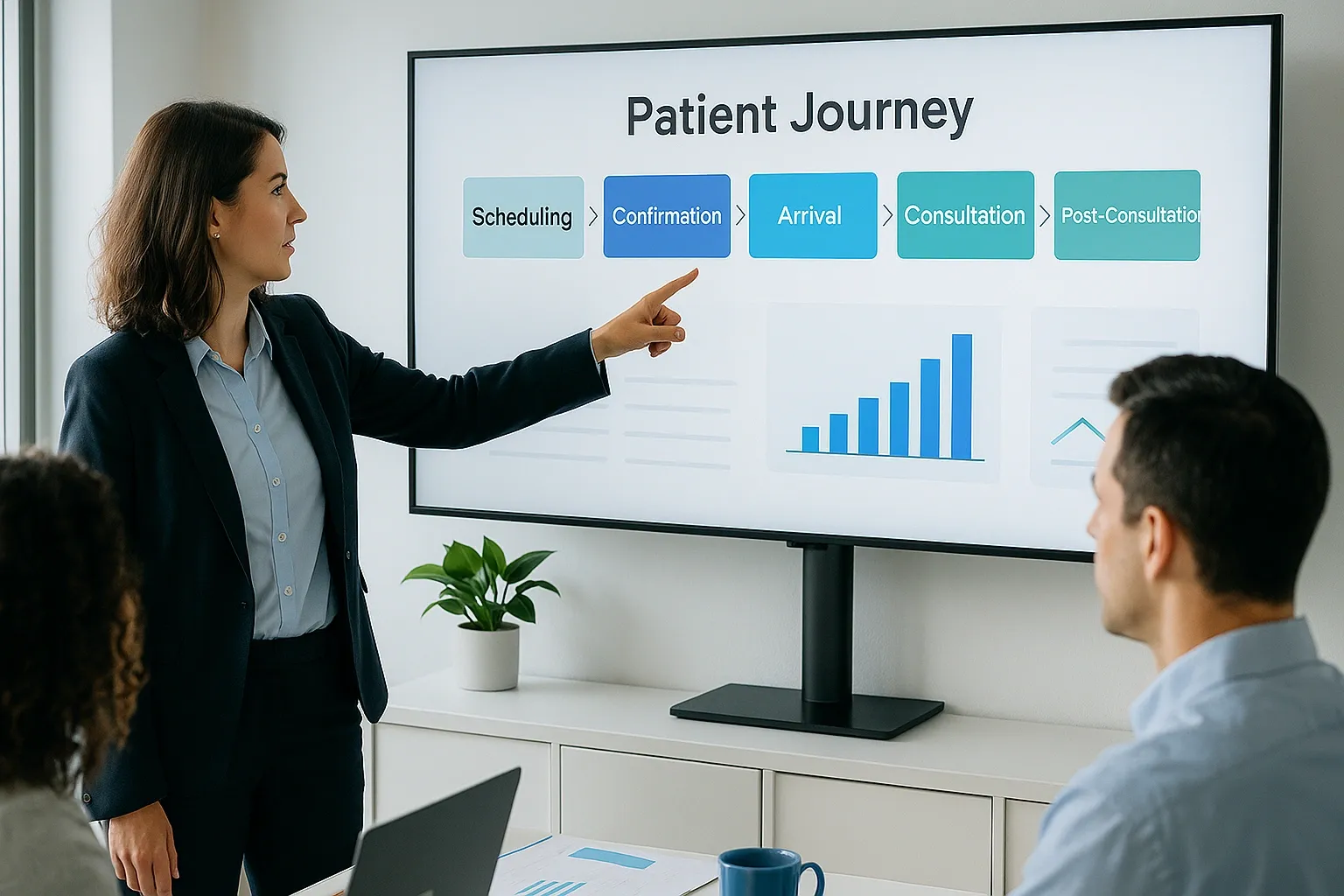
Patient loyalty doesn’t happen by chance—it’s the result of a consistent experience that begins long before the appointment and continues well into the follow-up. In a world where information is abundant and competition is intense, patients choose (and stay with) professionals and clinics that deliver convenience, clarity, and genuine care.
This article presents a practical roadmap to turn each touchpoint in the patient journey into a loyalty moment. We’ll explore strategies that combine humanized care, process organization, multichannel communication, and smart use of technology—without losing sight of medical ethics. The goal is for you to leave with concrete actions you can apply to your routine, regardless of practice size.
Before we continue, we need to ask: Are you already familiar with Ninsaúde Clinic? Ninsaúde Clinic is an intelligent software designed to simplify clinical management — combining an agile schedule, legally valid electronic health records, telemedicine, and complete financial control in one platform. Discover how Ninsaúde Clinic transforms daily operations and enhances patient care.

1) Map the entire patient journey from start to finish
Loyalty starts by mapping the full journey: discovery, scheduling, confirmation, arrival, encounter, payment, and follow-up. By identifying key touchpoints, you spot friction (e.g., difficulty booking, waiting room delays, uncertainty about test prep) and create targeted fixes. A simple journey map with owners and deadlines can transform daily operations.
Another step is to listen to patients at key moments. A short satisfaction message after the first visit, for example, reveals issues the team may not notice. The secret is closing the loop: collect feedback, prioritize fixes, and communicate improvements. When patients see progress, trust—and referrals—grow.

2) First impressions matter: easy access and clear communication
The relationship begins before the office. Responsive channels (WhatsApp, website with online scheduling like Ninsaúde Clinic, a working phone line) and concise replies reduce drop-offs. Welcome messages with directions, parking tips, required documents, and prep guidance build confidence. Avoid jargon and long blocks of text; use short lists and plain language.
Standardize communication without losing the personal touch. Message templates with variables (name, date, clinician) ensure consistency and speed, but leave room for a human note when needed. That balance signals both process and care.
3) Reminders that reduce no-shows without sounding robotic
No-shows undermine loyalty: they frustrate the team, disrupt the schedule, and create a sense of chaos. Automated reminders via WhatsApp/SMS and email 48 and 24 hours prior—with a simple Confirm/Reschedule option—lower absences. If there’s no response, a brief, empathetic day-of reminder helps prevent forgetfulness.
Tone is everything. Instead of “YOUR PRESENCE IS MANDATORY,” try “All set for today at 4:00 p.m.? If you need to reschedule, let me know here 😊.” Humanized messages invite dialogue—and that builds loyalty.
4) Arrival and front desk: the first 10 minutes set the tone
Environment, signage, a warm welcome, and clarity about wait times shape patient perception. Greet people by name, verify information quickly, and explain the next steps. A call board or TV with relevant clinic information reduces anxiety and reinforces a sense of organization.
Sending the patient intake form can be done in advance if you use a medical software like Ninsaúde Clinic. With it, you can also set up a call/display board and customize it with informational videos to make the reception area more engaging and less tense.
Be transparent about delays. If something comes up, give advance notice and offer a priority reschedule. Most patients understand disruptions when they feel respected and informed.
5) Clinical excellence with accessible communication
Clinical quality is non-negotiable, but how it’s perceived depends on communication. Explain the diagnosis and care plan in plain language, using visuals when possible. Check for understanding with open-ended questions (“What made the most sense to you?”) and end with written instructions.
Provide a visit summary with warning signs and contact information for questions. Beyond safety, this prevents unnecessary urgent care visits and strengthens trust in your practice.

6) Post-visit follow-up that builds continuity
The first 72 hours after the visit are decisive for loyalty. A brief follow-up text (“How are you feeling? Can I help with anything?”) is a positive surprise and reinforces ongoing care. If medications or tests were ordered, send reminders with prep guidance and return windows.
Schedule the follow-up before the patient leaves. When the next appointment is set (or tentatively booked with a reminder), you reduce forgetfulness and sustain clinical continuity—which benefits patient outcomes and your business.
7) Patient education: content that truly helps
Educating patients builds loyalty. Simple, objective materials—prep checklists, post-procedure guides, explanations of results—empower people and reduce uncertainty. An editorial calendar aligned with your most common visit reasons brings relevance and consistency.
Prioritize easy formats: short texts with illustrations, 60–90 second videos, and step-by-step carousels. Publish where your audience is (site/blog, WhatsApp, email). The goal isn’t volume—it’s usefulness.
8) Convenience is king: payments, documents, and telehealth
Every operational barrier invites disengagement. Offer multiple payment options (Pix, card, payment links), automatic receipts, and digital document delivery. For eligible cases, telehealth expands access and keeps continuity when distance or mobility is an issue.
Making life easier—from scheduling to payment—isn’t a “nice-to-have”; it’s core to the experience. When things flow, patients return and refer.

9) Multichannel relationships with clear guardrails
Patients have different preferences. Some respond better on WhatsApp, others via email. Record contact preferences and respect reasonable hours. Define internal SLAs (response times by channel) and use away messages after hours with clear options for urgent needs.
Standards ensure that relationship quality doesn’t depend on “who’s on shift.” The more predictable and respectful the communication, the stronger the bond.
10) Humanization as a process—not just a nice phrase
Empathy is sustained by trained routines. Hold brief, regular huddles to review service cases, learn from praise and complaints, and update scripts. Short, recurring training beats one-off workshops.
Encourage active listening and validation. Often, patients want to be understood before being convinced. When your team masters this skill set, conflicts diminish and satisfaction rises.
11) Metrics that prove loyalty is improving
If you don’t measure, you can’t improve. Track at least: no-show rate, return rate (e.g., patients who come back within 6–12 months), NPS/satisfaction, average wait time, and LTV (patient lifetime value). These indicators guide practical actions—reconfiguring reminders, adjusting visit lengths, creating procedure blocks, and strengthening follow-ups.
Set realistic targets and review weekly. Small, consistent gains (e.g., lowering no-shows by 2 percentage points per month) compound into major results by quarter’s end.
12) Service recovery: turn problems into trust
Errors and disruptions happen. What matters is how you respond. Apologize plainly, explain how you’ll fix the issue, and offer a proportionate make-good when appropriate (e.g., priority slot). Document the case and use it to prevent recurrence.
Well-handled recoveries increase loyalty. Patients recognize transparency and commitment—qualities that are rare and highly valued.
13) Ethics and privacy as pillars
Protecting confidentiality, obtaining consent, and safeguarding personal data are the foundation of any lasting relationship. Be clear about how contact information is used and offer opt-out for nonessential communications. That respect strengthens trust—essential for loyalty.
Beyond legal obligations, ethics should guide delicate decisions: promotions, “loyalty programs,” and perks must always honor professional standards and prioritize the patient’s best interest.
14) Small “wow” details (that don’t cost much)
Little gestures have big impact: water and coffee available, visible Wi-Fi password, outlets near chairs, neutral playlist, comfortable lighting. Remembering important timelines (e.g., the annual checkup or quarterly follow-up) shows ongoing care.
Digital cards with post-visit instructions, QR codes for feedback, and birthday messages with prevention tips turn “details” into proof of value. Patients remember who cared for them even when they weren’t in the room.
15) Technology as an experience multiplier
Integrated systems reduce noise and free your team to focus on what matters: care. Online booking with automated confirmations, an electronic health record with customizable templates, smart reminders, and a relationship CRM centralize information and make the schedule predictable.
If you use a full practice management platform, set up flows like: confirmation + re-engagement of no-shows, post-visit follow-ups, return reminders, and segmentation by condition. In a few days, patients notice the change: everything becomes easier, faster, and clearer.
Did you like this information? Then get ready for a continuous learning journey by following our blog. Are you a healthcare professional and don’t yet know the benefits of Ninsaúde Clinic? Stay ahead, optimize your processes, and raise the standard of patient care!

